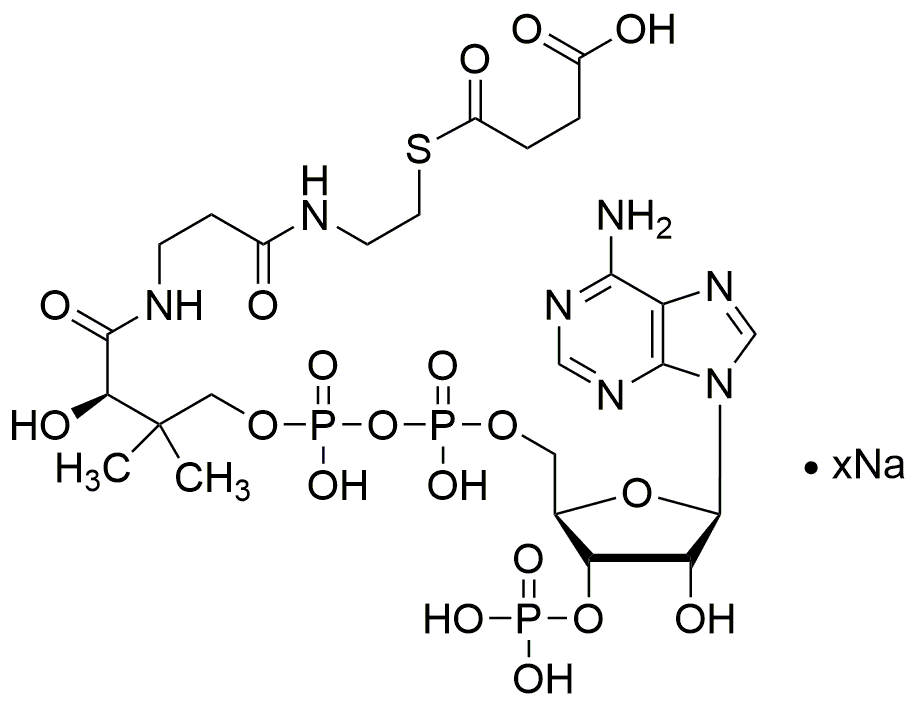Succinyl coenzyme A sodium salt is widely utilized in research focused on:
- Metabolic Studies: This compound plays a crucial role in the citric acid cycle, making it essential for researchers studying cellular respiration and energy production in various organisms.
- Biochemical Assays: It is commonly used in enzyme assays to evaluate the activity of enzymes involved in metabolic pathways, providing insights into enzyme kinetics and regulation.
- Pharmaceutical Development: The compound is explored in drug formulation, particularly in the development of therapies targeting metabolic disorders, enhancing drug efficacy and bioavailability.
- Food Industry Applications: Its role as a food additive helps in flavor enhancement and preservation, making it valuable for food scientists working on product development and safety.
- Biotechnology: Used in the production of biofuels and bioproducts, it supports researchers in optimizing fermentation processes and improving yield in microbial cultures.
Información general
Propiedades
Seguridad y normativas
Aplicaciones
Succinyl coenzyme A sodium salt is widely utilized in research focused on:
- Metabolic Studies: This compound plays a crucial role in the citric acid cycle, making it essential for researchers studying cellular respiration and energy production in various organisms.
- Biochemical Assays: It is commonly used in enzyme assays to evaluate the activity of enzymes involved in metabolic pathways, providing insights into enzyme kinetics and regulation.
- Pharmaceutical Development: The compound is explored in drug formulation, particularly in the development of therapies targeting metabolic disorders, enhancing drug efficacy and bioavailability.
- Food Industry Applications: Its role as a food additive helps in flavor enhancement and preservation, making it valuable for food scientists working on product development and safety.
- Biotechnology: Used in the production of biofuels and bioproducts, it supports researchers in optimizing fermentation processes and improving yield in microbial cultures.
Documentos
Hojas de datos de seguridad (HDS)
La SDS proporciona información de seguridad completa sobre la manipulación, el almacenamiento y la eliminación del producto.
Especificación del producto (PS)
La PS proporciona un desglose completo de las propiedades del producto, incluida la composición química, el estado físico, la pureza y los requisitos de almacenamiento. También detalla los rangos de calidad aceptables y las aplicaciones previstas del producto.
Certificados de análisis (COA)
Busque certificados de análisis (COA) ingresando el número de lote del producto. Los números de lote y de partida se pueden encontrar en la etiqueta de un producto después de las palabras "Lote" o "Lote".
Número de catálogo
Número de lote/lote
Certificados de origen (COO)
Este certificado de origen confirma el país en el que se fabricó el producto y también detalla los materiales y componentes utilizados en él y si se deriva de fuentes naturales, sintéticas u otras fuentes específicas. Este certificado puede ser necesario para cumplir con las normativas aduaneras, comerciales y regulatorias.
Número de catálogo
Número de lote/lote
Hojas de datos de seguridad (HDS)
La SDS proporciona información de seguridad completa sobre la manipulación, el almacenamiento y la eliminación del producto.
DownloadEspecificación del producto (PS)
La PS proporciona un desglose completo de las propiedades del producto, incluida la composición química, el estado físico, la pureza y los requisitos de almacenamiento. También detalla los rangos de calidad aceptables y las aplicaciones previstas del producto.
DownloadCertificados de análisis (COA)
Busque certificados de análisis (COA) ingresando el número de lote del producto. Los números de lote y de partida se pueden encontrar en la etiqueta de un producto después de las palabras "Lote" o "Lote".
Número de catálogo
Número de lote/lote
Certificados de origen (COO)
Este certificado de origen confirma el país en el que se fabricó el producto y también detalla los materiales y componentes utilizados en él y si se deriva de fuentes naturales, sintéticas u otras fuentes específicas. Este certificado puede ser necesario para cumplir con las normativas aduaneras, comerciales y regulatorias.


